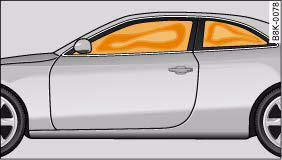How the head-protection airbags work
When fully inflated, the airbags reduce the risk of head or chest injury in a side collision.

Fig. 183 Head-protection airbags in inflated condition
In certain types of side collisions the head-protection airbag is triggered together with the side airbag on the impact side of the vehicle ⇒ fig. 183.
When the system is triggered, the airbag fills with a propellant gas and covers the entire area in front of the side windows, including the door pillars. In this way the system is able to protect both the front and the rear occupants on the side of the vehicle where the impact occurs. The head-protection airbag inflates to soften the impact if an occupant strikes parts of the interior or objects outside the vehicle with their head. By reducing the head impact and restraining uncontrolled movement of the head, the airbag also reduces the forces acting on the neck. In addition, since it covers the front door pillar when fully inflated, the head-protection airbag also gives extra protection if the car should collide with an obstacle at an oblique angle.
The front airbags, side airbags and head-protection airbags may be triggered together in certain types of accident.
In order to provide the desired extra protection in an accident, the airbags have to inflate extremely rapidly (within fractions of a second). The airbag releases a fine dust when it inflates. This is quite normal and does not mean there is a fire in the vehicle.
